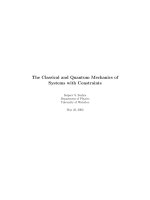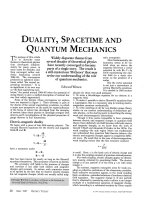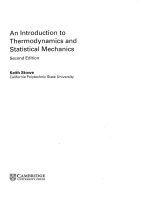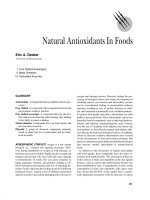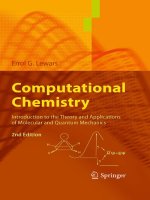- Trang chủ >>
- Khoa Học Tự Nhiên >>
- Vật lý
Mind, matter and quantum mechanics 3rd edition
Bạn đang xem bản rút gọn của tài liệu. Xem và tải ngay bản đầy đủ của tài liệu tại đây (2.26 MB, 303 trang )
the frontiers collection
www.pdfgrip.com
the frontiers collection
Series Editors:
A.C. Elitzur M. Schlosshauer M.P. Silverman J. Tuszynski R. Vaas H.D. Zeh
The books in this collection are devoted to challenging and open problems at the forefront of
modern science, including related philosophical debates. In contrast to typical research monographs, however, they strive to present their topics in a manner accessible also to scientifically
literate non-specialists wishing to gain insight into the deeper implications and fascinating
questions involved. Taken as a whole, the series reflects the need for a fundamental and interdisciplinary approach to modern science. Furthermore, it is intended to encourage active
scientists in all areas to ponder over important and perhaps controversial issues beyond their
own speciality. Extending from quantum physics and relativity to entropy, consciousness and
complex systems – the Frontiers Collection will inspire readers to push back the frontiers of
their own knowledge.
Other Recent Titles
Weak Links
Stabilizers of Complex Systems from Proteins to Social Networks
By P. Csermely
Mind, Matter and the Implicate Order
By P.T.I. Pylkkänen
Particle Metaphysics
A Critical Account of Subatomic Reality
By B. Falkenburg
The Physical Basis of the Direction of Time
By H.D. Zeh
Mindful Universe
Quantum Mechanics and the Participating Observer
By H. Stapp
Decoherence and the Quantum-To-Classical Transition
By M. Schlosshauer
The Nonlinear Universe
Chaos, Emergence, Life
By A. Scott
Symmetry Rules
How Science and Nature Are Founded on Symmetry
By J. Rosen
Quantum Superposition
Counterintuitive Consequences of Coherence, Entanglement, and Interference
By M.P. Silverman
Series home page – springer.com
www.pdfgrip.com
Henry P. Stapp
MIND, MATTER AND
QUANTUM MECHANICS
Third Edition
13
www.pdfgrip.com
Henry P. Stapp
University of California
Lawrence Berkeley National Lab.
1 Cyclotron Rd.
Berkeley CA 94720
USA
e-mail:
Series Editors:
Avshalom C. Elitzur
Bar-Ilan University, Unit of Interdisciplinary Studies, 52900 Ramat-Gan, Israel
email:
Maximilian A. Schlosshauer
University of Melbourne, Department of Physics, Melbourne, Victoria 3010, Australia
email:
Mark P. Silverman
Trinity College, Dept. Physics, Hartford CT 06106, USA
email:
Jack A. Tuszynski
University of Alberta, Dept. Physics, Edmonton AB T6G 1Z2, Canada
email:
Rüdiger Vaas
Posener Str. 85, 74321 Bietigheim-Bissingen, Germany
email:
H. Dieter Zeh
Gaiberger Straße 38, 69151 Waldhilsbach, Germany
email:
Cover Figure: Detail from ‘The Optiverse’, a video of the minimax sphere eversion by John M. Sullivan,
George Francis, and Stuart Levy, with original score by Camille Goudeseune.
More at />
ISBN 978-3-540-89653-1
e-ISBN 978-3-540-89654-8
DOI 10.1007/978-3-540-89654-8
Frontiers Collection ISSN 1612-3018
Library of Congress Control Number: 2008942368
© Springer-Verlag Berlin Heidelberg 2009
This work is subject to copyright. All rights are reserved, whether the whole or part of the material is
concerned, specifically the rights of translation, reprinting, reuse of illustrations, recitation, broadcasting,
reproduction on microfilm or in any other way, and storage in data banks. Duplication of this publication
or parts thereof is permitted only under the provisions of the German Copyright Law of September 9, 1965,
in its current version, and permission for use must always be obtained from Springer. Violations are liable
for prosecution under the German Copyright Law.
The use of general descriptive names, registered names, trademarks, etc. in this publication does not imply,
even in the absence of a specific statement, that such names are exempt from the relevant protective laws
and regulations and therefore free for general use.
Cover design: KuenkelLopka GmbH, Heidelberg
Printed on acid-free paper
987654321
springer.com
www.pdfgrip.com
For Olivia
www.pdfgrip.com
Preface to the Third Edition
The basic problem in the interpretation of quantum mechanics is to reconcile
the quantum features of the mathematics with the fact that our perceptual
experiences are described in the language of classical physics. Observed
physical objects appear to us to occupy definite locations, and we use the
concepts of everyday life, refined by the ideas of nineteenth-century physics,
to describe both our procedures for obtaining information about the systems
we are studying, and also the data that we then receive, such as the reading
of the position of a pointer on a dial. Yet our instruments, and our physical
bodies and brains, are in some sense conglomerates of atoms. The individual
atoms appear to obey the laws of quantum mechanics, and these laws include
rules for combining systems of atomic constituents into larger systems.
Insofar as experiments have been able to determine, and these experiments
examine systems containing tens of billions of electrons, there is no apparent
breakdown of the quantum rules. Yet if we assume that these laws hold all the
way up to visible objects such as pointers, then difficulties arise. The state
of the pointer would, according to the theory, often have parts associated
with the pointer’s being located in visibly different places. If we continue to
apply the laws right up to, and into, our brains, then our brains, as represented
in quantum mechanics, would have parts corresponding to our seeing the
pointer in several visibly different locations. Inclusion of the effects of the
environment does not remove any of these parts, although it does make it
effectively impossible to empirically confirm the simultaneous presence of
these different parts.
The orthodox solution to this problem is simply to postulate, as a basic
precept of the theory, that our observations are classically describable. This
postulate is incorporated into the theory by asserting that any conscious
observation will be accompanied by a “collapse of the wave function” or
“reduction of the wave packet” that will simply exclude from the prior
physically described state all parts that are incompatible with the conscious
experience. This prescription works beautifully. When combined with the
rule that the probability that this perception will occur is the ratio of the
www.pdfgrip.com
VIII
Preface to the Third Edition
quantum mechanical weighting of the reduced state to the quantum mechanical weighting of the prior state, one gets predictions never known to
fail. This ad hoc injection, in association with “consciousness”, of “classical” concepts into a theory that is mathematically incompatible with those
concepts, is the origin of the mysteriousness of quantum mechanics.
There is mounting evidence from neuroscience that our conscious
thoughts are associated with synchronous oscillations in well-separated sites
in the brain. This opens the door to a natural way of understanding, simultaneously, both the mind–brain and quantum–classical linkages. Oscillatory
motions play a fundamental role in quantum mechanics, and they embody an
extremely tight quantum–classical connection. This connection allows the
quantum–classical and mind–brain connections to be understood together
in a relatively simple and direct way.
Chapters 13 and 14 are new in this edition. Both describe simple models
that achieve a simultaneous solution of these two problems. The first paper, entitled “Physicalism Versus Quantum Mechanics”, is concerned more
with the philosophical aspects, whereas the second, entitled “A Model of
the Quantum–Classical and Mind–Brain Connections, and the Role of the
Quantum Zeno Effect in the Physical Implementation of Conscious Intent”
focuses more on technical matters pertaining to the question of the time
scales associated with the quantum-mandated influence of our conscious
intentional actions upon our physically described brains. These two papers,
and the second one in particular, involve more equations than any of the
other papers in the book. But these equations describe properties of simple
geometric structures, and the meanings of the equations are described also
in geometric terms.
To make room for the new articles without appreciably lengthening the
book, the old chapter 5 has been removed. Its content significantly overlapped that of other chapters, so its removal mainly eliminates redundancies.
The two new chapters describe in terms meant to be generally understandable to nonphysicists who are not uncomfortable with mathematics the
technical foundations of the approach to the mind–brain connection pursued
in this book and further developed in its sequel, the Springer volume Mindful
Universe: Quantum Mechanics and the Participating Observer.
Berkeley, October 2008
Henry P. Stapp
www.pdfgrip.com
Preface to the Second Edition
I have been besieged by requests for copies of this book, particularly since
the publication of The Mind and the Brain by Jeffrey Schwartz and Sharon
Begley. That book gave a popular-style account of the impact of these
quantum-based considerations in psychiatry and neuroscience. This is just
one example of the substantial progress that has been made during the decade
since the publication of the first edition of Mind, Matter, and Quantum
Mechanics in understanding the relationship between conscious experience
and physical processes in the brain.
Von Neumann’s Process I has been identified as the key physical process
that accounts, within the framework of contemporary physical theory, for the
causal efficacy of directed attention and willful effort. It is now understood
how quantum uncertainties in the micro-causal bottom–up physical brain
process not only open the door to a consciously controlled top–down process,
but also require the presence of this process, at least within the context of
pragmatic science.
These new developments fit securely onto the general framework presented in the first edition. They are described in a chapter written for this
new edition and entitled “Neuroscience, Atomic Physics, and the Human
Person”. This chapter integrates the contents of three lectures and a text
that I have prepared and delivered during the past year. Those presentations
were aimed at four very different audiences, and I have tried to adopt here
a style that will make the material accessible to all of those audiences, and
hence to a broad readership.
The material covered in that chapter is essentially scientific. The broader
ramifications are covered in a second new chapter entitled “Societal Ramifications of the New Scientific Conception of Human Beings”.
Berkeley, July 2003
Henry P. Stapp
www.pdfgrip.com
Preface to the First Edition
Nature appears to be composed of two completely different kinds of things:
rocklike things and idealike things. The first is epitomized by an enduring
rock, the second by a fleeting thought. A rock can be experienced by many
of us together, while a thought seems to belong to one of us alone.
Thoughts and rocks are intertwined in the unfolding of nature, as
Michelangelo’s David so eloquently attests. Yet is it possible to understand rationally how two completely different kinds of things can interact
with each other? Logic says no, and history confirms that verdict. To form
a rational comprehension of the interplay between the matterlike and mindlike parts of nature these two components ought to be understood as aspects
of some single primal stuff. But what is the nature of a primal stuff that can
have mind and matter as two of its aspects?
An answer to this age-old question has now been forced upon us. Physicists, probing ever deeper into the nature of matter, found that they were
forced to bring into their theory the human observers and their thoughts.
Moreover, the mathematical structure of the theory combines in a marvelous way the features of nature that go with the concepts of mind and
matter. Although it is possible, in the face of this linkage, to try to maintain
the traditional logical nonrelatedness of these two aspects of nature, that
endeavor leads to great puzzles and mysteries. The more reasonable way, I
believe, is to relinquish our old metaphysical stance, which though temporarily useful was logically untenable, and follow where the new mathematics
leads.
This volume brings together several works of mine that aim to answer
the question: How are conscious processes related to brain processes? My
goal differs from that of most other quantum physicists who have written
about the mind–brain problem. It is to explain how the content of each
conscious human thought, as described in psychological terms, is related
to corresponding processes occurring in a human brain, as described in
the language of contemporary physical science. The work is based on a
substantial amount of empirical data and a strictly enforced demand for
www.pdfgrip.com
Preface to the First Edition
XI
logical coherence. I call the proposed solution the Heisenberg/James model
because it unifies Werner Heisenberg’s conception of matter with William
James’s idea of mind.
The introduction, “. . . and then a Miracle Occurs”, was written specially
for this volume. It is aimed at all readers, including workers in psychology, cognitive science, and philosophy of mind. Those fields, like physics,
have witnessed tremendous changes during the century since William James
wrote his monumental text. My introduction places the Heisenberg/James
model in the context of that hundred-year development.
The main features of the model are described in “A Quantum Theory of
the Mind-Brain Interface”. This paper is an expanded version of a talk I gave
at a 1990 conference, Consciousness Within Science. The conference was
attended by neuroanatomists, neuropsychologists, philosophers of mind,
and a broad spectrum of other scientists interested in consciousness. The
talk was designed to be understandable by all of them, and the paper retains
some of that character. Together with the introduction and appendix (“A
Mathematical Model”) it is the core of the present volume.
“The Copenhagen Interpretation” is an older paper of mine, reprinted
from the American Journal of Physics. It describes the Copenhagen interpretation of quantum theory. That interpretation held sway in physics for
six decades, and it represents our point of departure.
The other papers deal with closely related issues. Many of the ideas
are to be found in my first published work on the problem, the 1982 paper
“Mind, Matter, and Quantum Mechanics”, from which this volume takes
its title. An overview of the model is given in “A Quantum Theory of
Consciousness”, which summarizes a talk I gave at a 1989 conference on
the mind–brain relationship.
The theory of the mind–brain connection described above is based on
Heisenberg’s ideas, and it accepts his position that the element of chance
is to be regarded as primitive. Einstein objected to this feature of orthodox
quantum thought, and Wolfgang Pauli eventually tried to go beyond the
orthodox view, within the context of a psychophysical theory that rested in
part on work of C. G. Jung. The possibility of extending the present theory
in this way is discussed in “Mind, Matter, and Pauli”.
“Choice and Meaning in the Quantum Universe” first describes some
attempts by physicists to understand the nature of reality, and then attempts
to discern, tentatively, a meaning intrinsic to natural process itself from an
analysis of the form of that process alone, without tying meaning to any
outside thing.
The mind–body problem is directly linked to man’s image of himself,
and hence to the question of values. The Heisenberg/James model of mind
www.pdfgrip.com
XII
Preface to the First Edition
and man is separated by a huge logical gulf from the competing Cartesian
model, which has dominated Western philosophic and scientific thought
for three centuries. Two of the included papers, “Future Achievements to
Be Gained through Science” and “A Quantum Conception of Man”, were
presented at international panels dealing with human issues, and they explore
the potential societal impact of replacing the Cartesian model of man by the
Heisenberg/James model. The second of these papers is the best introduction
to this book for readers interested in seeing the bottom line before going
into the technical details of how it is achieved.
The final chapter, “Quantum Theory and the Place of Mind in Nature”, is
a contribution to the book Niels Bohr and Contemporary Philosophy, which
is to appear this year. It examines the question of the impact of quantum
theory upon our idea of the place of mind in nature. This article can serve
as a short philosophical introduction to the present volume, although it was
a subsequent development in the evolution of my thinking.
In the above works I have tried to minimize the explicit use of mathematics. But in an appendix prepared for this volume I have transcribed
some key features of the model from prose to equations.
Among the scientists and philosophers who have suggested a link between consciousness and quantum theory are Alfred North Whitehead, Erwin Schrăodinger, John von Neumann, Eugene Wigner, David Albert and
Barry Loewer, Euan Squires, Evans Harris Walker, C. Stuart, Y. Takahashi,
and H. Umezawa, Amit Goswami, Avshalom Elitzur, Alexander Berezin,
Roger Penrose, Michael Lockwood, and John Eccles. Only the final two
authors address in any detail the problem addressed here: the nature of the
relationship between the physical and physiological structures. Eccles’s
approach is fundamentally different from the present one. Lockwood’s approach is more similar, but takes a different tack and does not attain the same
ends.
Berkeley, February 1993
Henry P. Stapp
www.pdfgrip.com
Acknowledgements
1
Supported by the Director, Office of Energy Research, Office of High
Energy and Nuclear Physics, Division of High Energy Physics of the
U.S. Department of Energy under Contract DE-AC03-76F00098.
2 Supported by the Director, Office of Energy Research, Office of High
Energy and Nuclear Physics, Division of High Energy Physics of the U.S.
Department of Energy under Contract DE-AC03-76F00098. Reprinted,
with permission of the publishers, from The Interrelationship between
Mind and Matter, edited by Beverley Rubic, Center for Frontier Sciences, Temple University, 1992.
3 Supported by the Director, Office of Energy Research, Office of High
Energy and Nuclear Physics, Division of High Energy Physics of the U.S.
Department of Energy under Contract DE-AC03-76F00098. Reprinted,
with permission of the publishers, from the American Journal of Physics
40, 1098–1116 (1972).
4 Supported by the Director, Office of Energy Research, Office of High
Energy and Nuclear Physics, Division of High Energy Physics of the U.S.
Department of Energy under Contract W-7405-EN-G-48. Reprinted,
with permission of the publishers, from Foundations of Physics 12, 363–
399 (1982).
5 Supported by the Director, Office of Energy Research, Office of High
Energy and Nuclear Physics, Division of High Energy Physics of the U.S.
Department of Energy under Contract DE-AC03-76SF00098. Invited
presentation to the conference “Consciousness Within Science”, held at
Cole Hall, University of California at San Francisco, 17–18 February
1990. Sponsored by the Bhaktivedanta Institute.
6 Supported by the Director, Office of Energy Research, Office of High
Energy and Nuclear Physics, Division of High Energy Physics of the U.S.
Department of Energy under Contract DE-AC03-76SF00098. Invited
lecture at the Symposium on the Foundations of Modern Physics 1992:
www.pdfgrip.com
XIV
Acknowledgements
“The Philosophic Thought of Wolfgang Pauli”, held in Helsinki, 10–12
August 1992.
7
8
9
Supported by the Director, Office of Energy Research, Office of High
Energy and Nuclear Physics, Division of High Energy Physics of the
U.S. Department of Energy under Contract DE-AC03-76SF00098. Invited presentation at the congress “Science et Tradition; Perspectives
Transdisciplinaires, Ouvertures vers le XXI`eme Si`ecle”, UNESCO, 2–6
December 1991.
Contribution to the panel discussion “The Permanent Limitations of
Science”, sponsored by the Claremont Institute, Claremont, California,
14–16 February 1991. Other panelists: Roger D. Masters, Leon Kass,
Edward Teller, Fred Hoyle, Stanley Jaki, Robert Jastrow.
Supported by the Director, Office of Energy Research, Office of High
Energy and Nuclear Physics, Division of High Energy Physics of the U.S.
Department of Energy under Contract DE-AC03-76SF00098. Invited
paper for the Third UNESCO Science and Culture Forum—“Toward
Eco-Ethics: Alternative Visions of Culture, Science, Technology, and
Nature”, held in Belem, Brazil, 5–10 April 1992. The introductory
section of this paper was written in collaboration with Olivia B. Stapp.
10 Supported by the Director, Office of Energy Research, Office of High
Energy and Nuclear Physics, Division of High Energy Physics of the U.S.
Department of Energy under Contract DE-AC03-76SF00098. Contribution to the volume Niels Bohr and Contemporary Philosophy, edited
by Jan Faye and Henry J. Folse (Kluwer, Dordrecht, 1993).
11 Based on a section from “The Volitional Influence of the Self and Mind
(with Respect to Emotional Self-regulation)”, by Jeffrey M. Schwartz,
Henry P. Stapp, and Mario Beauregard in Consciousness, Emotional
Self-regulation and the Brain, edited by Mario Beauregard (John Benjamins, Amsterdam & Philadelphia, 2003).
12 Based on a talk delivered at the “Future Visions” conference sponsored
by the International Space Sciences Organization and the John Templeton Foundation that was held in conjunction with the annual State of the
World Forum meeting 4–9 September 2000 in New York City.
13 Supported by the Director, Office of Science, Office of High Energy
and Nuclear Physics, of the U.S. Department of Energy under Contract
DE-AC02-05CH11231. I thank Ed Kelly for many useful suggestions
pertaining to the form of this paper.
14 Supported by the Director, Office of Science, Office of High Energy
and Nuclear Physics, of the U.S. Department of Energy under Contract
www.pdfgrip.com
Acknowledgements
XV
DE-AC02-05CH11231. I thank Efstratios Manousakis, Kathryn Laskey,
Edward Kelly, Tim Eastman, Ken Augustyn, and Stan Klein for valuable
suggestions.
www.pdfgrip.com
Contents
Part I Introduction
1
. . . and then a Miracle Occurs
2
A Quantum Theory of Consciousness
3
39
Part II Theory
3
The Copenhagen Interpretation
4
Mind, Matter, and Quantum Mechanics
5
A Quantum Theory of the Mind–Brain Interface
51
81
119
Part III Implications
6
Mind, Matter, and Pauli
7
Choice and Meaning in the Quantum Universe
8
Future Achievements to Be Gained through Science
9
A Quantum Conception of Man
10 Quantum Theory and the Place of Mind in Nature
149
159
171
181
193
Part IV New Developments and Future Visions
11 Neuroscience, Atomic Physics, and the Human Person
12 Societal Ramifications of the New Scientific Conception
of Human Beings
13 Physicalism Versus Quantum Mechanics
14 A Model of the Quantum–Classical and Mind–Brain
Connections, and the Role of the Quantum Zeno Effect in the
Physical Implementation of Conscious Intent
Part V Appendices
A Mathematical Model
Glossary
Further References
Index
203
237
245
261
277
281
291
293
www.pdfgrip.com
Part I
Introduction
www.pdfgrip.com
1 . . . and then a Miracle Occurs
A satisfactory understanding of the connection between mind and matter
should answer the following questions: What sort of brain action corresponds to a conscious thought? How is the content of a thought related to
the form of the corresponding brain action? How do conscious thoughts
guide bodily actions?
Answers to these questions have been heretofore beyond the reach of
science: the available empirical evidence has been unable to discriminate
between alternative theories. Recently, however, mind/brain research has
provided powerfully discriminating data that lift these questions from the
realm of philosophy to that of science and lend strong support to definite
answers.
In attempts to understand the mind–matter connection it is usually assumed that the idea of matter used in Newtonian mechanics can be applied
to the internal workings of a brain. However, that venerable concept does
not extrapolate from the domain of planets and falling apples to the realm of
the subtle chemical processes occurring in the tissues of human brains. Indeed, the classical idea of matter is logically incompatible with the nature of
various processes that are essential to the functioning of brains. To achieve
logical coherence one must employ a framework that accommodates these
crucial processes. A quantum framework must be used in principle.
Quantum theory is sometimes regarded as merely a theory of atomic
phenomena. However, the peculiar form of quantum effects entails that ordinary classical ideas about the nature of the physical world are profoundly
incorrect in ways that extend far beyond the properties of individual atoms.
Indeed, the model of physical reality most widely accepted today among
physicists, namely that of Heisenberg, has gross large-scale nonclassical
effects. These, when combined with contemporary ideas about neural processing, lead to a simple model of the connection between mind and brain
that is unlike anything previously imagined in science. This model accommodates the available empirical evidence, much of which is highly restrictive
and from traditional viewpoints extremely puzzling.
www.pdfgrip.com
4
1 . . . and then a Miracle Occurs
Competing theories of the mind–brain connection seem always to have
a logical gap, facetiously described as “. . . and then a miracle occurs”. The
model arising from Heisenberg’s concept of matter has no miracles or special
features beyond those inherent in Heisenberg’s model of physical reality
itself. The theory fixes the place in brain processing where consciousness
enters, and explains both the content of the conscious thought and its causal
efficacy.
This model of the mind/brain system is no isolated theoretical development. It is the rational outcome of a historical process that has occupied
most of this century, and that links a series of revolutions in psychology and
physics. Although the model can be discussed in relative isolation, it is best
seen within the panorama of the twentieth-century scientific thought from
which it arose.
The historical and logical setting for these developments is the elucidation by William James, at the end of nineteenth century, of the clash between
the phenomenology of mind and the precepts of classical physics. I shall
presently describe some of James’s key points, and will then review, from
the perspective they provide, some of the major twentieth-century developments in psychology: the behaviorist movement, the cognitive revolution,
and the dominant contemporary theme, materialism. On the physics side,
the crucial developments are Einstein’s special theory of relativity, quantum theory, the Einstein–Podolsky–Rosen paradox, and the development
of some models of physical reality that meet the demands imposed by the
nature of quantum phenomena. Among these models the one proposed by
Heisenberg is, in my opinion, the best. Coupled to James’s conception of
mind it produces a model of the mind–matter universe that realizes within
contemporary physical theory the idea that brain processes are causally influenced by subjective conscious experience.
This model of the mind/brain links diverse strands of science, principally
physics, psychology, and brain physiology. I shall endeavor to provide the
necessary background in all three areas. However, I do not follow historical
order but construct instead a rational narrative.
The first critical point, which underlies everything else, is the fact that the
peculiarities of nature revealed by quantum phenomena cannot be dismissed
as esoteric effects that appear only on the atomic scale. The Einstein–
Podolsky–Rosen paradox, by itself, makes manifest the need for a radical
restructuring of our fundamental ideas about the nature of physical reality.
It also shows that this restructuring cannot be confined to the atomic scale.
Quantum physicists have for years been proclaiming this need for a profound
revision of ordinary ideas about the nature of the physical world. But their
reasons have usually been based upon interpretations of atomic phenomena
www.pdfgrip.com
1.1 The Einstein–Podolsky–Rosen Paradox
5
that are accessible only to experts in the field. To outsiders the whole
business has remained shrouded in mystery. But the EPR paradox is a
puzzle that can be expressed wholly in terms of behaviors of objects that are
directly observable to the unaided eye.
To convince the reader that something is fundamentally wrong with
ordinary ideas about nature I shall begin with a description of this paradox.
1.1 The Einstein–Podolsky–Rosen Paradox
In 1935 Albert Einstein, Boris Podolsky, and Nathan Rosen wrote a famous paper1 that led to what is now seen to be an unexpected property
of nature: an apparent need, at some deep level, for strong instantaneous
actions over large distances. This conclusion, which is diametrically opposed to Einstein’s own ideas about nature, is deduced from the predictions
that quantum theory makes in certain special kinds of experimental circumstances. Typically, these are situations in which two experimenters perform
at the same time, but in well-separated regions, independent measurements
upon a single extended system. Each experimenter is allowed to freely
choose—and then immediately perform—one of two alternative possible
measurements on the large system. The combination of the two measurements, one performed by each of the two experimenters, is called here a
pair of measurements.
In this situation there are four alternative pairs of measurements that
might be performed. For each of these four pairs quantum theory makes an
assertion about the connection between the outcomes of the two measurements. Einstein and his collaborators showed that these assertions, taken
together, conflicted with strongly held ideas about the nature of physical reality. Over the years important generalizations of the original EPR arguments
have been constructed, and the conflict has been sharpened considerably.
The most recent version of the EPR paradox is based on an experiment
devised by Lucien Hardy.2 The experimental details are unimportant in the
present context. What is important is that a certain experimental procedure
is used to produce a large collection of similarly prepared systems, and that
each of these systems is then subjected to a pair of measurements. These
two measurements are performed at the same time in two far-apart regions.
The measurement performed in each region will be one of two alternative
possible measurements, and the outcome of each performed measurement
will be one of two alternative possible outcomes.
To make the description more pictorial, without changing the logic,
I shall say that one of the two alternative measurements in each region
www.pdfgrip.com
6
1 . . . and then a Miracle Occurs
Figure 1 A diagrammatic representation of the predictions of quantum theory for
the Hardy version of the EPR experiment.
measures “color” and the other measures “size”. These two words are just
a graphic shorthand for the two particular measurements that have been
described in detail by Hardy. The device that measures “color” fills a onecubic-foot box, and has a visible pointer that swings either to a position
marked “black” or to a position marked “white”. The device that measures
“size” is a similar device, with positions marked “large” and “small”. One
or the other of the two possible measurements can be performed in each
region, not both.
Quantum theory, transcribed into our language, makes four assertions
pertaining to this situation. It will be shown that these four assertions,
taken together, are logically incompatible with the following reasonablesounding locality assumption: the last-minute choice by the experimenter
www.pdfgrip.com
1.1 The Einstein–Podolsky–Rosen Paradox
7
in one region about which of the two measurements he will perform in that
region cannot affect an outcome that appears far away at the same time under
a fixed faraway experimental condition. This assumption is similar to the
key locality assumption used by Einstein, Podolsky, and Rosen.
The four assertions of quantum theory are these (see Figure 1):
1
2
3
4
If “size” were to be measured in region 1 and the outcome there were to
be “large”, then if “color” were to be measured in region 2 the outcome
there would be “white”.
If “color” were to be measured in region 2 and the outcome there were to
be “white”, then if “color” were to be measured in region 1 the outcome
there would be “black”.
If “color” were to be measured in region 1 and the outcome there were
to be “black”, then if “size” were to measured in region 2 the outcome
there would be “small”.
If “size” were to be measured in both regions, then, in a large collection
of paired measurements, both outcomes will be “large” in approximately
one-sixteenth of the instances.
I shall now show how these four assertions of quantum theory, combined
with our assumption of no action at a distance, lead to a logical contradiction. Readers not interested in following though the details of the logical
argumentation can skip to the end of the section in small type.
The argument goes as follows. Suppose predictions 1 and 2 of quantum theory
are correct. And suppose that no matter which of the two alternative possible measurements is performed in region 1 the outcome appearing there must be independent
of which measurement is performed in region 2. And suppose a similar property
with regions 1 and 2 interchanged also holds. Then the following conclusion holds:
Conclusion A. Suppose “size” is measured in region 1 and the outcome there
is “large”. Then if “color” instead of “size” had been measured in region 1,
the outcome there would necessarily have been “black”.
To verify this result suppose that “size” is measured in region 1 and that the
outcome there is “large”, just as the supposition of conclusion A demands. Suppose,
moreover, that “color” is measured in region 2, just as the condition of prediction 1 of
quantum theory demands. Then this prediction implies that the result in region 2 must
be “white”. Given this result “white”, and the assertion that this outcome in region 2
cannot depend upon which measurement is performed in region 1, prediction 2
of quantum theory implies that if “color” instead of “size” had been measured in
region 1, then the outcome there would necessarily have been “black”.
This is the claimed conclusion. However, one extra assumption was used: it
was assumed that “color” was measured in region 2. That condition can be dropped.
For one of our assumptions is that no matter which measurement is performed in
region 1 the outcome there must be independent of which measurement is performed
in region 2. Hence the connection established between results in region 1 cannot be
disturbed by changing what we do in region 2.
www.pdfgrip.com
8
1 . . . and then a Miracle Occurs
The natural interpretation of conclusion A is that, under the conditions of the
experiment, whatever is measured in region 1 is “black” if it is “large”. However,
that inference goes beyond what is actually proved, for it depends on the additional
assumption that there is an existing “something” that “has” the properties that are
measured. But one idea in quantum theory is that there may be nothing in nature that
possesses simultaneously the two properties that are represented here by the words
“large” and “black”. We do not wish to prejudge that idea, and hence will stick with
our more conservative conclusion A.
Conclusion A combined with prediction 3 of quantum theory yields:
Conclusion B. Suppose “size” is measured in region 1 and the outcome
appearing there is “large”. Then if “size” is measured also in region 2, the
outcome appearing in region 2 must be “small”.
The assumption here is exactly the assumption of conclusion A. Hence we can
use the conclusion: if “color” instead of “size” had been measured in region 1, then
the outcome in region 1 would necessarily have been “black”. But then prediction 3,
coupled with the assertion that the result in region 2 cannot depend on which measurement is performed in region 1, implies that the result of the measurement of
“size” in region 2 must be “small”. This is what conclusion B asserts.
Conclusion B contradicts prediction 4 of quantum theory. Thus the predictions
of quantum theory are logically incompatible with the assertion that the outcome
of any measurement performed on one part of a quantum system must be independent of which measurement is performed simultaneously on a faraway part: large
quantum systems seem to behave, at least in some special situations, as if they were
instantaneously linked-up wholes.
The entire argument refers only to large visible objects, namely the
macroscopic positions of devices and their pointers. Indeed, the predictions of orthodox quantum theory are, in principle, always assertions about
such observable things. The details of the procedure by which these predictions are derived is not germane to our conclusion, which is simply that the
predictions themselves are incompatible with the EPR assumption that no
influence can act instantaneously over large distances.
EPR-type paradoxes are not just freak anomalies in quantum theory:
they pervade the theory. Discovered in the mid-1930s by Schrăodinger and
Einstein, they have been, ever since, a chief focal point of the study of
the foundations of physics. Numerous international conferences of physicists and philosophers have centered on the EPR problem, and references to
“EPR” are ubiquitous in the foundational literature. The EPR-type phenomena apparently entail the need for strong instantaneous influences, at some
deep level, and this evidently entails, in turn, the need for a major restructuring of our ideas about the fundamental nature of the physical universe.
Physicists have devised three alternative possible ways of understanding
how the predictions of quantum theory can be valid. I shall describe these
www.pdfgrip.com
1.2 James’s Conception of Mind
9
three models later. All are “radical”: none conform to conventional ideas
about the nature of the physical world.
I revert now to historical order.
1.2 James’s Conception of Mind
James defines psychology as the science of mental life, where the latter
includes such things as “feelings, desires, cognitions, reasonings, decisions,
and the like”.3 He immediately distinguishes two possible ways of unifying
the material, the spiritualistic, and the associationistic approaches. The
former seeks to “affiliate the divers mental modes . . . upon a simple entity,
the personal soul”, whereas the latter seeks “common elements in the divers
mental facts rather than a common element behind them”. In chapter I,
after describing a host of disparate facts about mental life he says of the
spiritualistic approach that
our explanation becomes as complicated as the crude facts with which we
started. Moreover there is something grotesque and irrational in the supposition that the soul is equipped with elementary powers of such an ingeniously
intricate sort.4
On the other hand, he argues that
the pure associationist’s account of our mental life is almost as bewildering
as that of the pure spiritualist. This multitude of ideas, existing absolutely,
yet clinging together, and weaving an endless carpet of themselves, like
dominoes in ceaseless change, or the bits of glass in a kaleidoscope,
whence do they get their fantastic laws of clinging, and why do they cling
in just the ways they do?5
James, in his answer, cites numerous instances of evident mind–brain
connection to support the conclusion that
the spiritualist and the associationist must both be “cerebralists”, to the
extent of at least admitting that certain peculiarities in the way of working
of their own favorite principles are explicable only by the fact that the brain
laws are a codeterminant of the result.6
This conclusion elevates the problem of the mind–brain interaction into a
place of central importance in Jamesian thought.
After an extensive review of habit and reflex action, James raises the
issue of the automaton theory:
The conception of reflex action is surely one of the best conquests of psychological theory; why not be radical with it? Why not say that just as
the spinal cord is a machine with a few reflexes, so the hemispheres are a
www.pdfgrip.com
10
1 . . . and then a Miracle Occurs
machine with many, and that that is all the difference? The principle of
continuity would press us to accept such a view.7
. . . so simple and attractive is this conception from the consistently physiological point of view, that it is wonderful to see how late it was stumbled on
in philosophy, and how few people, even when it is explained to them, fully
and easily realize its import.8
Descartes made a step in the direction of this “conscious automaton theory”,
but it was not till 1870, I believe, that Mr. Hodgson made the decisive step,
by saying that feelings, no matter how intense they may be present, can have
no causal efficacy whatever.9
James goes on to recount hearing a most intelligent biologist say:
“It is high time for scientific men to protest against the recognition of any
such thing as consciousness in a scientific investigation.”10
James’s rejoinder:
In a word, feeling constitutes the “unscientific” half of existence, and any one
who enjoys calling himself a “scientist” will be only too happy to purchase
an untrammeled homogeneity in terms of the studies of his predilection,
at the slight cost of admitting a dualism which, in the same breath that it
allows to mind an independent status of being, banishes it to a limbo of
causal inertness, from which no intrusion or interruption on its part need
ever be feared.11
James cites, nevertheless, one reason for accepting the causal inertness
of consciousness:
Over and above this great postulate that things must be kept simple, there
is, it must be confessed, still another highly abstract reason for denying
causal efficacy to our feelings. We can form no positive image of the modus
operandi of a volition or other thought affecting the cerebral molecules.12
He quotes, from an “exceedingly clever writer”, a passage that ends with
the sentences:
“Try to imagine the idea of a beefsteak binding two molecules together. It
is impossible. Equally impossible is it to imagine a similar idea loosening
the attractive forces between two molecules.”13
This seeming impossibility of even imagining how an idea, or a thought,
could influence the motions of molecules in the brain is certainly a main
support for the highly counterintuitive notion that mind cannot influence
matter. If there were a simple model showing how such an influence could
occur, in a completely natural way, and within the framework of the established laws of physics, then the notion that our thoughts cannot effect our
actions would undoubtedly lose much of its appeal.
www.pdfgrip.com
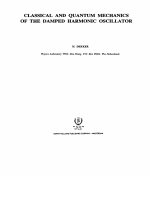
![Lecture notes on c algebras and quantum mechanics [jnl article] n lamdsman](https://media.store123doc.com/images/document/14/rc/rt/medium_6PjfnHupCQ.jpg)
